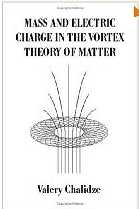Mass and Electric Charge in the Vortex Theory of Matter
 | |
| Author | Valery Chalidze |
|---|---|
| Published | 2001 |
| Publisher | Universal Publishers |
| Pages | 108 |
| ISBN | 1581126751 |
The book presents foundations of the vortex theory of matter based a philosophical framework of classical physics with certain suppositions about the nature of physical space which is traditionaly called aether (ether). Twisted vortex rings with left and right rotation are models of particles and anti-particles. Vortex rings of radius equal to the radius of a vortex cord is a model of a photon. Division of that ring into two rings with opposite twist is a model of pair production. The hypothesis of the topological identity of an electron's and proton's rings lead to values of masses for mu, pi, K and tau particles which are close to experimental. A model of electric field as field of vorticular filaments is presented. It is shown that the square of an elementary charge is proportional to the Plank constant and speed of light.
From the Publisher
The book presents foundations of the vortex theory of matter based a philosophical framework of classical physics with certain suppositions about the nature of physical space which is traditionaly called aether (ether). Twisted vortex rings with left and right rotation are models of particles and anti-particles. Vortex rings of radius equal to the radius of a vortex cord is a model of a photon. Division of that ring into two rings with opposite twist is a model of pair production. The hypothesis of the topological identity of an electron's and proton's rings lead to values of masses for mu, pi, K and tau particles which are close to experimental. A model of electric field as field of vorticular filaments is presented. It is shown that the square of an elementary charge is proportional to the Plank constant and speed of light.